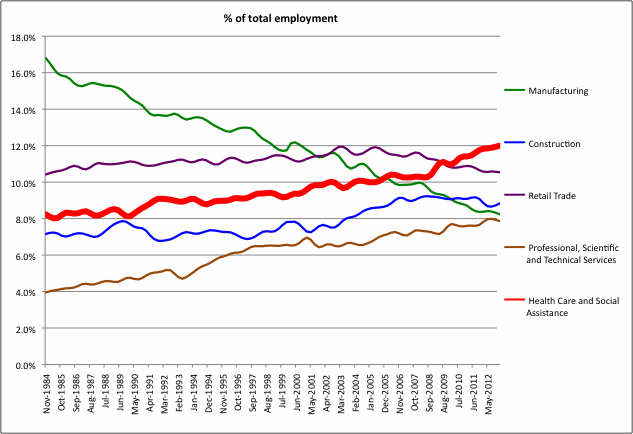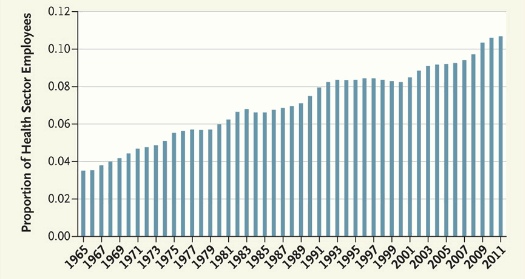It’s Australia’s fastest-growing industry by employment, rivalled only by our burgeoning services sector and the mining industry. It’s the biggest single employer of Australians, with one in eight of us working in it. And it shows no signs of slowing down. Right now, nearly 1.4 million Australians work in the health and social care sector. On current rates of growth, before the decade is out, one in seven of us will be in the sector.
As the Grattan Institute pointed out yesterday in its look at Australian government budgets, rapidly growing healthcare spending is putting significant pressure on budgets. But the rapidly growing health workforce has big implications for the rest of the economy. Where will we get the doctors, nurses, dentists and physios of tomorrow? What pressures will that place elsewhere? These are the sorts of issues the Commonwealth has an entire division within the Department of Health set up to deal with (Melissa Sweet at Croakey has looked at these issues).
How did we end up with health as our biggest employment sector? It’s natural to think that our ageing population has caused that, but the answer is more complicated. This chart drawn from ABS industry employment data shows the growth of health as a proportion of employment against the rise and fall of other industries.
The sector has enjoyed similar growth to professional services, albeit from a higher base. But unlike that sector, healthcare has had the benefit of continuing to grow through recessions, at a time when other areas faced retrenchment. So, for instance, manufacturing, which faced the twin assault of tariff cuts and a recession, fell precipitately between 1989 and 1991 in terms of employment, while health grew strongly, and then maintained its level of employment for the rest of the decade. Health employment got another kick around the time of the tech wreck and the early 2000s slowdown, which sent it above 10% of the workforce for the first time. And the sharpest growth of all was during the financial crisis, when the sector rapidly climbed to 11% of the workforce. Nor has it slowed since then.
And compare construction, an industry highly sensitive to economic conditions: in both the early 1990s and during the GST-induced slowdown in the sector, sector employment slumped toward 7%. While the Rudd government’s stimulus packages minimised the slump in employment during the financial crisis, once the First Home Owners’ Boost ended, it fell.
The resilience of the health sector in continuing to add jobs even during economic slowdowns, which turbocharged its rise to become the biggest employer in the economy, isn’t entirely because it is primarily government-driven. The United States, where the private sector plays a much bigger role in its absurdly expensive and inefficient healthcare system, has seen similar resilience. This graph from a New England Journal of Medicine article of the US healthcare workforce as a proportion of non-farm employment (in contrast to the ABS data above, which is all employment) shows the US healthcare workforce similarly surging during economic slowdowns:
“The health care sector is an economic mainstay, providing stability and even growth during times of recession,” claimed the American Hospital Association. Although, as the NEJM article notes, the constant growth in the US health workforce has not yielded comparable improvements in health outcomes.
But the Australian and American experience of constantly growing health workforces isn’t universal. Canada has had a very different experience. In 2012, the Canadian healthcare workforce was 11.1% of the non-farm workforce — virtually the same as it was in 1995. Between 1991 and 2012, the Canadian health workforce has varied between 10% (in 2000) and 11.1% as a proportion of the non-farm workforce. Indeed, healthcare spending in Canada is now growing more slowly than the rest of the economy.
Why? Canada has the same issue of an ageing population as Australia and the US. Like Australia, the bulk of healthcare spending in Canada is via provincial governments. But in the 1990s, healthcare spending in Canada collapsed. Why? Canada faced a public debt crisis in the mid-19990s and from 1994, provincial governments and the federal government dramatically slashed spending in an effort to balance budgets. Healthcare was a primary victim of the austerity régime.
As a result, Cananda’s health workforce, which was high as a proportion of the rest of the Canadian workforce compared to the US and Australia in the early 1990s, peaked at 11% in 1995 and then actually fell through the rest of the decade, only beginning to recover after the turn of the century, until it, too, was boosted by the economic slowdown occasioned by the financial crisis.
The lesson from Canada — both from the 1990s and now — is that an ageing population doesn’t necessarily drive rising healthcare expenses: increased spending is a choice of governments, until they are faced with having no choice but to cut back, as Canadian governments were in the mid-1990s.
This dovetails with the conclusion reached by the Grattan Institute, that it is more use of the health system, not an ageing population, that has driven the bulk of the rise in Australia’s healthcare expenditure, even though we’re getting much better value out of our health system than the Americans are.
As we face a future in which health seems destined to become one of the dominant sectors of the economy, it’s worth remembering that there’s nothing inevitable about it.










This public funding of health care is an invitation to all involved to health industry to grab as much money from the honey pot as possible by what ever means they can come up with. The main culprits are the health insurers, who pocket huge amounts mandated by government. When the Howard government came up with private health insurance rebates the flood gates to easy money which was a gift and which needs to be investigated by the corruption watch dog.
The Grattan Institute – I’m waiting for this mob to address the issues involved in following question:
How long can Australia afford to tolerate the spectacle of, as in the small township of Dimboola, two schools both taxpayer funded?
The Grattan Institute serves those who fund it. Views on public policy are framed by that service so I may be waiting a while.
The obvious question this raises – how do health outcomes in Canada compare to Australia?
It’s fear of the health minister at the time being asked by Tracy Grimshaw, “What do you say to the family of Joe Bloggsworth, who died from a medical stuff up that the nurses and doctors unions say was contributed to by your drive for efficiency in health spending? And what do you say to his 9 year old son who is live in the studio with me?”
A locum doctor at a regional hospital gets paid $2000 per day plus a govt car, mobile phone free flights to metro and free rent